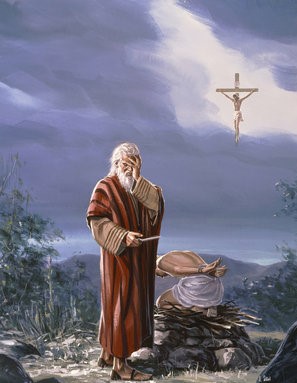
But to be fair to ourselves, we cannot simply sweep aside the contradictions between the Bible’s world and our own. The Torah emerged from a culture radically different from our own, so in fairness we cannot impose upon it our contemporary values. Although the story and several others will no doubt challenge a young person’s sensibilities and sense of justice, I believe it’s good for children to begin struggling with these moral tensions, so vividly dramatized in our holiest book. Similarly, Avi Katz replaced his original sketch for this story, depicting Abraham with knife upraised above his bound son with a less disturbing image: Abraham and Isaac ascending the mountain, the father with his head bowed and knife still sheathed, and the son following behind. More importantly, I’ve replaced the term “burnt offering,” repeated six times, with the less visceral “sacrifice.” (However, I don’t use this word in the title because Jews have always known this story as “akedat Yitzhak,” the binding of Isaac, not the sacrifice.) The language has been slightly simplified. My own version is not that different from the JPS translation, with a few key exceptions. This brief story, recounted in 19 verses totaling 270 Hebrew words, has generated endless debate and commentary. Perhaps no Bible story is more troubling, especially to children, than “The Binding of Isaac,” which we read every Rosh Hashanah in synagogue. Some stories I excluded as being inappropriate for young readers, but I felt obliged to include a few troubling stories because they are pivotal to understanding the Jewish national story. My choices were guided mainly by my sense of what makes a good story for children. I selected 53 stories to include in the book. But I also wanted to give children a feel for the special language that characterizes sacred texts. I tried to be mindful of young readers’ reading level, cultural literacy and developmental maturity. I made many judgment calls as I worked - about vocabulary, translation, editorial intervention, censorship and gendered language. So, too, are the names of people and places, of holy days and sacred acts. are present in these stories, but the specific ways that these techniques play out are unique to the Hebrew Bible. All the familiar techniques of good storytelling - suspense, dramatic irony, repetition, word play, stock characters, etc. I want readers and listeners to appreciate the simple narrative style of the Bible: sentences anchored in active subjects and verbs, few adjectives or adverbs, only rare editorializing by the narrator. The stories in my book are abridged but not improved or modernized.

I also wanted to reproduce the unique texture and rhythm of biblical language, using as my guide the 1985 JPS English Translation (NJPS), which itself tried to capture the idiomatic nuances of biblical Hebrew. My chief aim in writing the “JPS Illustrated Children’s Bible” was to teach children this important distinction, to present the Hebrew Bible on its own terms, without interpretation or embellishment.

It wasn’t until much later that I learned what was in and out of the sacred canon. So, like many other Jews, I thought the Hebrew Bible included the legends of Lilith, Abraham smashing his father’s idols and Elijah’s visits to my seder table. PHILADELPHIA (JTA) - When I was growing up, no one told me the difference between the Torah and midrash. The “JPS Illustrated Children’s Bible” opted to run the Avi Katz illustration showing Abraham with his head bowed and knife sheathed, with Isaac trailing behind.


 0 kommentar(er)
0 kommentar(er)
